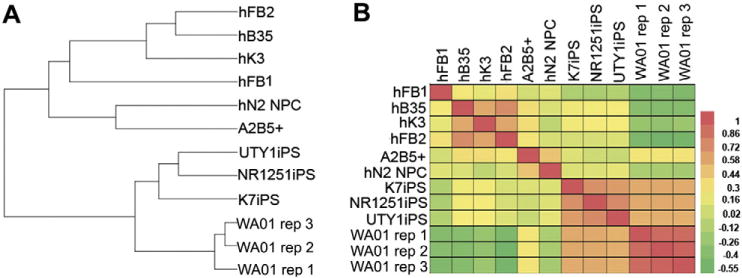Fig. 4.

Genome-wide gene expression profiling of U-iPSC derived A2B5 cells and comparison of A2B5 cells to neural progenitor cells. (A) Dendrogram. (B) Heatmap. Global gene expression is compared for human fibroblasts (hFB1, hFB2), patient derived urine cells (USCs, hB35, hK3), iPSCs derived from patient fibroblasts (NR1251 iPS, UTY1 iPS), iPSCs derived from patient urine cells (U-iPSCs, K7 iPS), human embryonic stem cells (WA01 replicates 1, 2, and 3), NPCs derived from hESCs (hN2 NPC), and A2B5+ cells derived from U-iPSCs. Urine cell-derived, Sendai virus reprogrammed U-iPSC K7iPS clusters together with fibroblast-derived, Sendai virus-reprogrammed human iPSC line (NR1251iPS), and fibroblast-derived, retrovirus-reprogrammed human iPSC (UTY1 iPS), as well as previously characterized hESC line WA01 (replicates 1, 2, and 3). iPSC-derived A2B5+ NPCs, patient derived urine cells hB35 and hK3 cluster much closer to the human fibroblasts (hFB1, and hFB2) than to iPSCs or hESCs. Most importantly, A2B5+ NPCs cluster together with previously characterized hESC derived NPCs (hN2 NPC).
